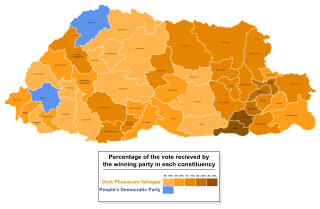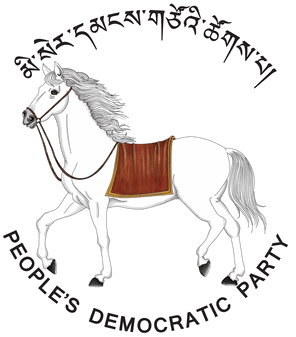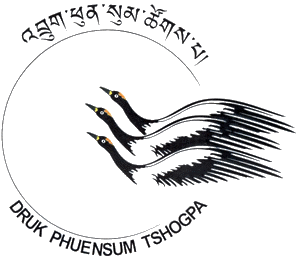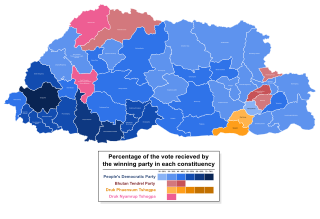
National Assembly elections were held in Bhutan for the first time on 24 March 2008. Two parties were registered by the Election Commission of Bhutan to contest the elections; Druk Phuensum Tshogpa, led by Jigme Y. Thinley, which was formed by the merger of the Bhutan People's United Party and All People's Party, and the People's Democratic Party (PDP). A third political party, the Bhutan National Party (BNP), had its application for the registration refused.
The development of Bhutanese democracy has been marked by the active encouragement and participation of reigning Bhutanese monarchs since the 1950s, beginning with legal reforms such as the abolition of slavery, and culminating in the enactment of Bhutan's Constitution. The first democratic elections in Bhutan began in 2007, and all levels of government had been democratically elected by 2011. These elections included Bhutan's first ever partisan National Assembly election. Democratization in Bhutan has been marred somewhat by the intervening large-scale expulsion and flight of Bhutanese refugees during the 1990s; the subject remains somewhat taboo in Bhutanese politics. Bhutan was ranked 13th most electoral democratic country in Asia according to V-Dem Democracy indices in 2023 with a score of 0.535 out of 1.

The People's Democratic Party is one of the major political parties in Bhutan, formed on 24 March 2007. The founder president of this party is Sangay Ngedup, the former prime minister and agriculture minister of the Royal Government of Bhutan. The current leader of the party is Tshering Tobgay. The People's Democratic Party submitted its application for registration on 6 August 2007 and thus became the first political party in Bhutan to do so. On 1 September 2007 the Election Commission of Bhutan registered the party. The PDP tends to be more popular in the west of the country.

Druk Phuensum Tshogpa is one of the major political parties in Bhutan. It was formed on 25 July 2007 as a merger of the All People's Party and the Bhutan People's United Party, which were both short-lived. The working committee of the merged entity, headed by the former home minister, Jigmi Yoezer Thinley, decided on the name for the new party. On 15 August 2007, Jigmi Yoezer Thinley was elected president of the party, and the party applied for registration, thus becoming the second political party in Bhutan to do so. On 2 October 2007, the Election Commission of Bhutan registered the party. On 24 March 2008, the party won the first general election held in Bhutan. The party secured 45 of the 47 seats to the National Assembly. The party tends to be more popular in the east of the country.

The National Assembly is the elected lower house of Bhutan's bicameral Parliament which also comprises the Druk Gyalpo and the National Council.

Tshering Tobgay is a Bhutanese politician, environmentalist, and cultural advocate who is the Prime Minister of Bhutan since 28 January 2024 and also served in office from July 2013 to August 2018. Tobgay is the leader of the People's Democratic Party, and was also the Leader of the Opposition in the National Assembly from March 2008 to April 2013.

Druk Nyamrup Tshogpa, formerly the Social Democratic Party, is one of the five registered political parties in Bhutan. It was registered on 20 January 2013. The DNT was Bhutan's governing party from 2018 to 2023.

Pema Gyamtsho is a Bhutanese politician who served as the Second Party President of the Bhutan Peace and Prosperity Party and Opposition Leader in the National Assembly of Bhutan from 2013 until his resignation in 2020. Since then he has been the Director General of International Centre for Integrated Mountain Development (|ICIMOD). He also served as the Minister of Agriculture and Forests in the first elected government of Bhutan.
AumDorji Choden is a Bhutanese politician. She was appointed minister of Bhutan's Works and Human Settlement Ministry in 2013, making her the first woman to serve as a minister in Bhutanese cabinet.
Ugyen Wangdi is a Bhutanese politician who was a Druk Phuensum Tshogpa (DPT) member of the National Assembly of Bhutan from October 2018 to 2023. Previously he was member of the National Assembly from 2013 to 2018.
Dorji Wangdi is a Bhutanese politician who has been the leader of the Bhutan Peace and Prosperity Party since 2020, and a member of the National Assembly of Bhutan, from 2008 to 2024. He is former the Opposition leader of Bhutan after the resignation of Pema Gyamtsho from active politics.
Kezang Wangmo is a Bhutanese politician, actress, poet, singer, dancer and goodwill ambassador for organic farming in Bhutan. Kezang was born in Paro District, in western Bhutan, where she learned to act at her school.

The Bhutan Kuen-Nyam Party was a social democratic political party in Bhutan. Its President from May 2017 to July 2020 was Dasho Neten Zangmo, who took over from Sonam Tobgay, the President from 2013 to 2017. Neten Zangmo was provisionally replaced by vice-president Sonam Tobgay until a new party convention was held.

National Assembly elections were held in Bhutan in 2018; the first round was held on 15 September and the second round on 18 October.

Dasho Dr. Lotay Tshering is a Bhutanese politician and surgeon who was the prime minister of Bhutan, in office from 7 November 2018 to 1 November 2023. He was the president of Druk Nyamrup Tshogpa (DNT) since 14 May 2018 until he resigned in 2025.
DrungtshoKarma Wangchuk is a Bhutanese politician who was a member of the National Assembly of Bhutan from October 2018 to 2023.
Hemant Gurung is a Bhutanese politician who has been a member of the National Assembly of Bhutan, since October 2018. Previously, he was a member of the National Assembly of Bhutan from 2008 to 2013.
Ugen Tenzin is a Bhutanese politician who has been a member of the National Assembly of Bhutan, since October 2018. Previously, he was a member of the National Assembly of Bhutan from 2008 to 2013.

National Assembly elections were held in Bhutan on 30 November 2023 and 9 January 2024.
















